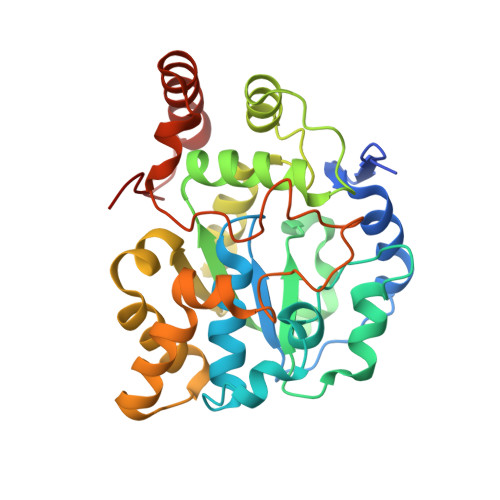The gate that governs sulfotransferase selectivity.
Cook, I., Wang, T., Almo, S.C., Kim, J., Falany, C.N., Leyh, T.S.(2013) Biochemistry 52: 415-424
- PubMed: 23256751
- DOI: https://doi.org/10.1021/bi301492j
- Primary Citation of Related Structures:
4GRA - PubMed Abstract:
Human cytosolic sulfotransferases (SULTs) transfer the sulfuryl moiety (-SO(3)) from activated sulfate [3'-phosphoadenosine 5'-phosphosulfate (PAPS)] to the hydroxyls and primary amines of numerous metabolites, drugs, and xenobiotics. Receipt of the sulfuryl group often radically alters acceptor-target interactions. How these enzymes select particular substrates from the hundreds of candidates in a complex cytosol remains an important question. Recent work reveals PAPS binding causes SULT2A1 to undergo an isomerization that controls selectivity by constricting the opening through which acceptors must pass to enter the active site. The enzyme maintains an affinity for large substrates by isomerizing between the open and closed states with nucleotide bound. Here, the molecular basis of the nucleotide-induced closure is explored in equilibrium and nonequilibrium molecular dynamics simulations. The simulations predict that the active-site "cap," which covers both the nucleotide and acceptor binding sites, opens and closes in response to nucleotide. The cap subdivides into nucleotide and acceptor halves whose motions, while coupled, exhibit an independence that can explain the isomerization. In silico weakening of electrostatic interactions between the cap and base of the active site causes the acceptor half of the cap to open and close while the nucleotide lid remains shut. Simulations predict that SULT1A1, the most abundant SULT in human liver, will utilize a similar selection mechanism. This prediction is tested using fulvestrant, an anti-estrogen too large to pass through the closed pore, and estradiol, which is not restricted by closure. Equilibrium and pre-steady-state binding studies confirm that SULT1A1 undergoes a nucleotide-induced isomerzation that controls substrate selection.
- Department of Microbiology and Immunology, Albert Einstein College of Medicine, 1300 Morris Park Avenue, Bronx, New York 10461-1926, USA.
Organizational Affiliation:

















